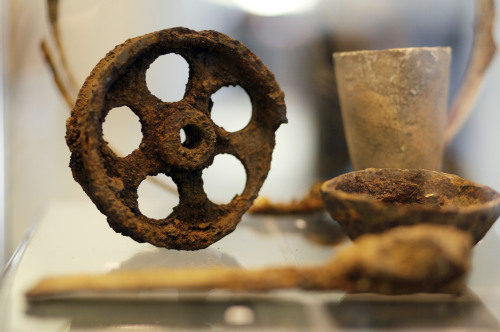SAN FRANCISCO (AP) ― The big dig for San Francisco’s multibillion dollar transportation terminal has unearthed some artifacts from during and after the city’s heady Gold Rush days, including opium pipes from a Chinese laundry and a chipped chamber pot found in a backyard outhouse.
The 70 artifacts have city archeologists eager for more and local residents pondering the ground beneath their feet.
“It’s not often that you get a chance to stop for a moment and have a window into what used to be,” said James M. Allan, an archeologist with William Self Associates, the firm ensuring the items are unearthed and preserved. “It gives you pause.”
The $4 billion Transbay Transit Center under construction in the South of Market financial district is billed as the “Grand Central Station of the West.” The 1 million-square-foot (90,000-square-meter) bus and train station will serve as the northern end of California’s planned high-speed rail line between San Francisco and Los Angeles; the West Coast’s tallest skyscraper is slated to rise above the center.
It’s all sleek and modern ― and on the same blocks once inhabited by working-class Irish immigrants and Chinese laborers who lived back to back on the sand dunes of the busy Gold Rush port known as Yerba Buena Cove.
They were the Donahues and the Dollivers, the Wings and the Lings, and the now-seemingly quaint accoutrements of their lives are being unearthed: clay opium pipes and ceramic tea pots from China; French perfume bottles; dainty English serving dishes, apothecary jars and the heads of hand-painted porcelain dolls; as well as animal bone toothbrushes and abandoned chamber pots.

A rope pulley, crucibles and a chisel are shown at an exhibit of artifacts in San Francisco, recently dug up from the Transbay Terminal construction site. Archaeologists working at the site during demolition of the old terminal have unearthed artifacts that help reveal what it must have been like to live in the Irish working-class neighborhood that existed in that part of the South of Market in the mid- to late 1800s. (AP-Yonhap News)
They all date back to the mid-to-late 1880s, when the cove was reclaimed and clapboard houses went up on Mission, Natoma and Minna streets, between First and Beale. They were filled with Irish, Swedish, German and Italian immigrants, as well as the Chinese who had come during the Gold Rush and then stayed on to help build the railroads and bridges.
Today’s residents and workers can see the exhibit in the lobby of the building that houses the Transbay Joint Powers Authority.
“I live and work in the neighborhood so I’ve been walking by the excavation site for a while and resisting the temptation to sneak in and see what might be lying around,” said Tom Pagel, an investment adviser. “The neighborhood has changed so much in a relatively short period of time. It’s a big evolution and gives you a glimpse into how the world has changed in those years.”
The artifacts are accompanied by historic photos and documents, including an 1885 article from the San Francisco Chronicle in which Irish landlords ― J.S. and Mary W. Dolliver ― were seeking $500 in damages from Ah Wing and 11 Chinese tenants for the “offensive smells from the laundry that have injured the rental value of the plaintiff’s premises.”
Today, Ming Ng is a Chinese engineer with a firm that hopes to work on bus storage for the new terminal. He had just held a meeting with Transbay officials upstairs and checked out the exhibit as he was leaving the building.
“It’s very interesting to see the pottery compared to the metal things that are all rusted and ruined,” the engineer said, looking at a pristine blue-and-white Chinese tea pot, then pointing toward a rope pulley and iron chisel found in the back yard of a brick mason.
“The pottery looks almost new,” he said. He then smiled and noted, “That’s the Chinese character for longevity.”
Allan said the artifacts were not necessarily unique and that they expect to unearth hundreds more.
“What is unusual is that we were able to identify the people and occupations of the early Gold Rush,” he said. “When the Gold Rush started in the 1850s, the miners came here and there was no place for them to live, so they lived in the sand dunes and then tent camps. We found the evidence: a wooden floor and a lot of bottles, barrels, a privy, leather shoes and boots.”
They would have worked in the Risdon Iron Works ― which built pipes for Hawaiian plantations ― the Selby Smelting Works, Miners Foundry or the San Francisco Gas and Light Co.
Allan said his favorite find was an oblong, earthen storage jar found fully intact. The unglazed pot with a thin neck and bulbous belly was used to store grain, olives or water.
“It’s the equivalent of today’s plastic water bottle in that they were used, and used, and then thrown away,” Allan said.
He also likes a porcelain chamber pot found at the bottom of an outhouse. It might have been part of a toiletry set sold by Sears back then for $2.25.
“Typically that goes under the bed and you use it at night so you don’t have to go out and use the privy,” Allan said. “I found it sort of ironic that we would find a chamber pot in the privy.”
Ellen Joslin Johnck, an archeologist who ducked in to see the exhibit, said the items should give San Franciscans “pride and ownership” of their city.
“To me, this lends more understanding and a greater appreciation for what it took to build this great city,’” she said.





![[KH Explains] How should Korea adjust its trade defenses against Chinese EVs?](http://res.heraldm.com/phpwas/restmb_idxmake.php?idx=645&simg=/content/image/2024/04/15/20240415050562_0.jpg&u=20240415144419)
